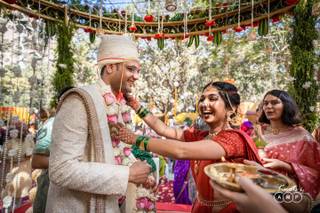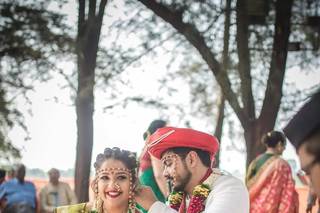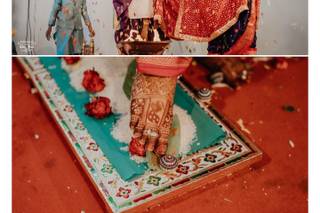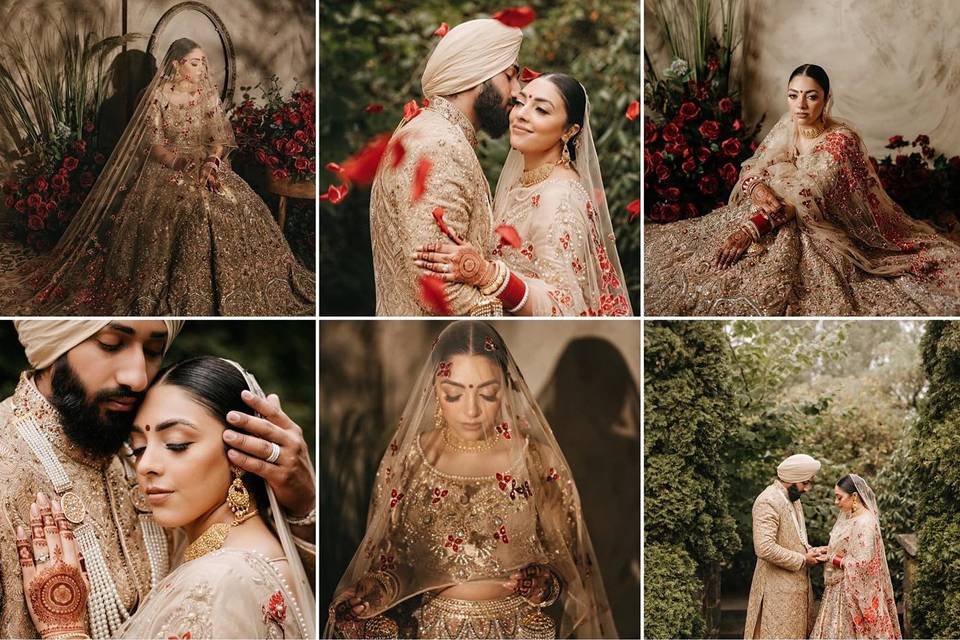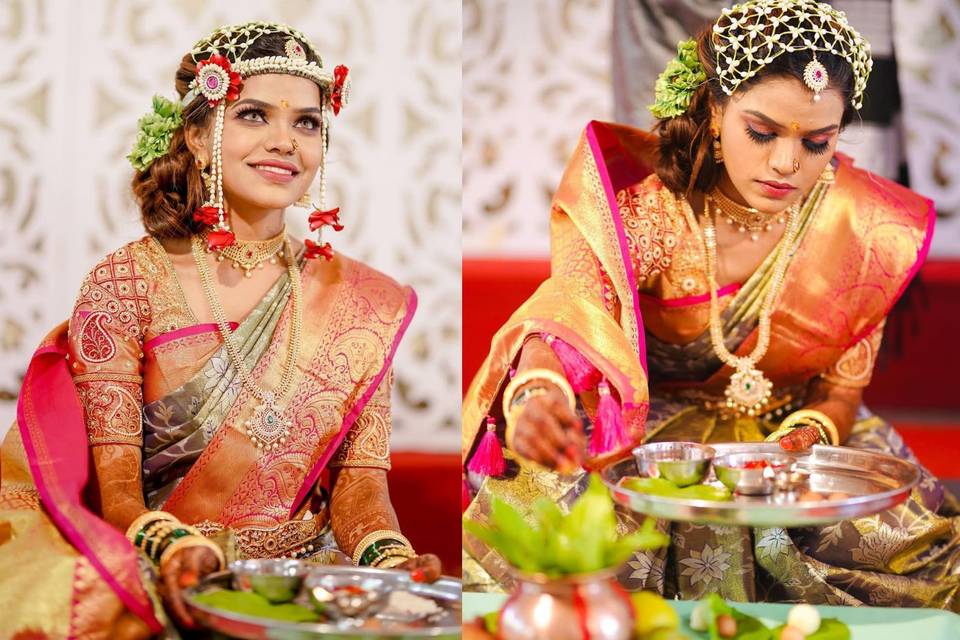Decoding Indian Weddings: Maharashtrian Wedding Rituals, Dresses And More
Planning a Maharashtrian wedding? Read all about the traditional wedding rituals and their significance here.

Photography: Knots by AMP
The first thought that comes to mind upon seeing a Marathi wedding is, “Simple is beautiful.”. Precise rituals like Sakhar Puda, hassle-free ceremonies like Halad Chadavane, and a bride dressed in a vibrant Navari—you can quickly identify these elements of a Maharashtrian wedding. If you're looking for ways to plan a typical Maharashtrian wedding, let us help with a quick guide to each wedding ceremony.
The beginning of all Maharashtrian wedding rituals is the Aaple Lagna, which takes place with the guidance, role, and support of every family member, as the familial bond is a strong thread in Marathi culture. Once you send out the lagna paprikas, here is how you can also incorporate them into your wedding plan.
In this article:
- Maharashtrian Pre-wedding rituals
- Maharashtrian Wedding rituals
- Post-wedding Maharashtrian rituals
- Traditional Maharashtrian wedding dress & jewellery
- Things to Remember
Here are all the Marathi wedding rituals in detail, allowing you to explore the beauty of this regal culture in depth.
Maharashtrian Pre-wedding rituals

Photography: Little Big Weddings
All the pre-wedding ceremonies and rituals that take place at a Marathi wedding:
Lagnaach Bedior
The horoscopes, or patrikas, of the bride and groom, are matched before any further proceedings. The family priests fix an auspicious time and date for the wedding or the Maharashtrian vidhi. This ritual was more prevalent earlier when the respective parents of the bride and groom arranged all the Maharashtrian wedding rituals.
Sakhar Puda
This is the official engagement ceremony, or the Roka ceremony, in Marathi/Maharashtrian weddings, signified by sakura, or sweets. The groom’s mother applies Haldi-Kumkum to the bride’s forehead as a blessing and gifts her with a saree, jewellery, Sakhar Puda, or sweets. The mother of the bride follows the same rituals for the groom. After this, the couple exchanges engagement rings as a part of the wedding rituals of Maharashtra. This ceremony can be celebrated immediately after the Maharashtrian wedding vidhi is picked or even during the pre-wedding period.
Muhurt Karane
After the wedding vidhi is fixed and the engagement is celebrated, the Maharashtrian wedding rituals begin in full swing. The preparation for the wedding starts months before the big day. The bride's mother invites suhasanies, or married women. They begin making turmeric powder and Sandege (pulses and spice powder) in a mortar and pestle to be used later in the wedding. Rolling of Papad is yet another significant pre-wedding activity of Muhurt Karane. And then starts the shopping! The women then hold a Rukhvat by decorating artistically and exhibiting bridal lehengas and sarees, jewellery, kitchen utensils, sweets, and all sorts of bridal trousseau as a part of the wedding rituals of Maharashtra.
The Wedding Invitation
As an integral part of Marathi wedding traditions, the first invitation is offered to Lord Ganesha for his blessings. After that, the other invitation cards are sent out.
Kelvan
This is performed a few days before the wedding. Both families perform a puja to their Kuldevta, or family deity, for blessings. Meals with family and close friends usually follow this ceremony.
Halad Chadavane
The same married women from Muhurta Karane perform this Maharashtrian version of Haldi. They apply turmeric paste with mango leaves to the groom's forehead, shoulders, hands, and feet. The paste is then taken to the bride, and the same ritual is performed with the bride.
Top Wedding Photographers In Maharashtra
Maharashtrian Wedding rituals
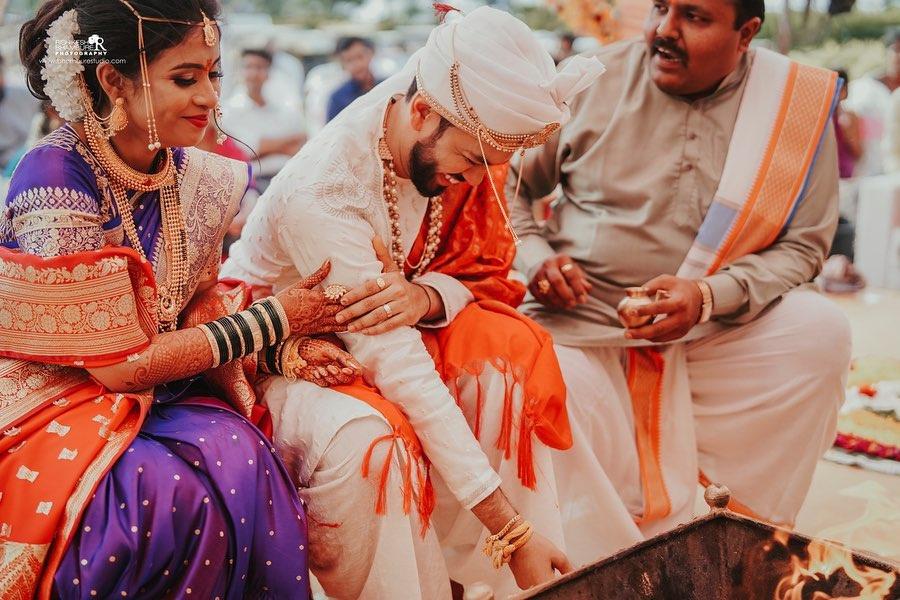
The Marathi wedding rituals are a combination of pujas and vows. Some wedding traditions are similar to some of the South Indian wedding traditions, like Saptapadhi and Kanyadaan, but there is some uniqueness in some of the Maharashtrian wedding ceremonies, too. Read here:
Ganpati Puja, Devdevak and Gurihar Puja
Like many other auspicious Maharashtrian occasions, the wedding day commences with the worship of Lord Ganesha. Ganpati Puja is performed to ensure a bright future for the couple. Devdevak follows up by inviting the family deity to the wedding mandap. In Gurihar Puja, the bride, all dressed up in her wedding attire, worships the goddess Parvati for her prosperous life. The bride's maternal uncle gives her some rice, which she then offers to the goddess.
Punyavachan and Seemanpuja
The bride’s parents take her to the wedding venue and ask everyone to bless their daughter on Punyavachan. In Seemanpuja, the bride’s mother receives him with Aarti and sweets upon the groom's arrival. She washes the groom’s feet and applies tilak to his forehead.
Antarpat
The groom enters the Mandap and sits on a designated wedding spot. The antarpat, or curtain, is hung in front of the groom, restricting his vision of the bride, who’d be sitting opposite him.
Sankalp
The bride then enters the Mandapa, and the priest chants Mangalashtakas, or sacred vows, accompanied by musicians. At an auspicious moment, the antarpat is removed, and the couple exchanges jai mala. That’s when everyone showers them with akshata, or whole rice.
Kanyadaan
The father of the bride gives away his daughter to the bridegroom with blessings. The groom promises to love and respect his wife forever.
Lajahoma
For the final Marathi marriage rituals to commence, a sacred fire is ignited, and the bride offers grains to the fire, chanting three mantras repeated by the groom. However, only the bride silently utters the fourth mantra. After that, the bride’s parents worship the couple as avatars of Vishnu and Laxmi, and the couple then tie a turmeric thread to each other’s hands. As a final touch, the groom ties the Mangalsutra around the bride’s neck and puts vermillion on her forehead.
Saptapadhi
After saying out loud the seven wedding vows, the couple encircles the holy fire seven times while performing the Marathi marriage ritual of Saptapadi.
Karmasamapti
The couple performs the Laxmi Pujan and worships until the fire goes out. The groom then gives the bride a new name. Finally, the bride's brother teasingly twists the groom’s ear to remind him of his marital duties, and the couple takes everyone’s blessings in the end.
Upto 30% off on Vendor Bookings
Post-wedding Maharashtrian rituals

Photography: The Storyteller Official
Here are the common Marathi marriage rituals that take place post-wedding in a traditional Marathi wedding:
Varat
Varat in a Maharashtrian wedding means the bride's farewell from her parents’ home to her new family. Usually, a procession follows the bride to her in-laws’ house. While the bride bids her goodbyes, the groom carries the Parvati idol from Gaurihar Puja.
Grihapravesh
The groom's family is happy to welcome the newlyweds. The groom's mother performs Aarti and washes the couple’s feet with milk and water. The bride is then asked to push down a kalash of rice at the entrance, and they both enter the house, putting their right foot forward.
Reception
After all the Marathi marriage rituals, the final celebration party is organized. Here, the bride and groom are introduced to all the guests. The bride wears a saree gifted to her by the groom’s family, and the groom wears an outfit gifted by the bride’s parents.
Top Bridal Makeup Artists Near You
Traditional Maharashtrian Wedding dress & jewellery

The Groom:
A traditional Maharashtrian groom’s wedding outfit is an off-white, cream, or beige cotton Kurta paired with a white, thin-bordered Kanche or Dhoti. There is a fancy red or gold-coloured stole that the groom wraps around his shoulders in style. There is a pheta, turban, or a white Gandhi-style hat for the head.
The Bride:
A Maharashtrian bride wears the most colourful silk sarees with exquisite gold borders. The saree is usually draped in a typical Marathi dhoti style. The most popular color combinations are yellow, orange, purple, and green. Generally, two kinds of sarees are worn in a Marathi wedding: six yards of Paithani or nine yards of Navari. As for jewellery, green glass bangles, Mangalsutra, Thusi, or their traditional necklace, Maharashtrian armlets, and a moon-shaped Bindi are the indispensable components of Marathi bridal wear.
The bride and groom wear a Mundavalya - a string of pearls attached to their headband.
Best WeddingWear Stores in Maharashtra
Things to remember:

- Have clear conversations with both the family priests regarding dates and timings
- Some couples opt for an elaborate engagement on Sakhar Puda. It’s entirely your choice. Just ensure you don’t hurt any religious feelings or offend anyone in the family. Try to put forward your views without hampering the traditions as much as possible.
- For Rukhwat, you can also opt for handmade baskets, handicrafts, or creative packing with the trousseaus. This will add a little spin to traditional events.
- Ensure all the Puja Samagri the priest explains is available and present during the nuptials and other Marathi wedding rituals.
- If you’re planning a destination or weekend wedding out of town, ensure you have everything you need for the rituals and ceremonies. Consult with your wedding planner to make backup plans in case of unavailability.
- If you’re planning to blend traditional and modern weddings in your Maharashtrian marriage rituals, get help from your wedding decorator to choose an appropriate theme
Simple yet graceful; vibrant yet elegant—a Maharashtrian wedding has flavours of culture and traditions as well as fun and playfulness, as seen in the Marathi wedding rituals in the details above. However, you can have fusion for your Marathi wedding rituals by blending traditional and modern values. Go to an exotic location for your Marathi wedding and follow all the rituals. Thank your guests with creative return gifts without disturbing the conventional Maharashtrian marriage rituals and customs. Make your Lagnachya Katha the favourite saga of your family and friends! Plan a flawless Marathi wedding checklist to ensure your wedding is a super hit for all to remember!
Decoding Indian Weddings with WeddingWire India:
















